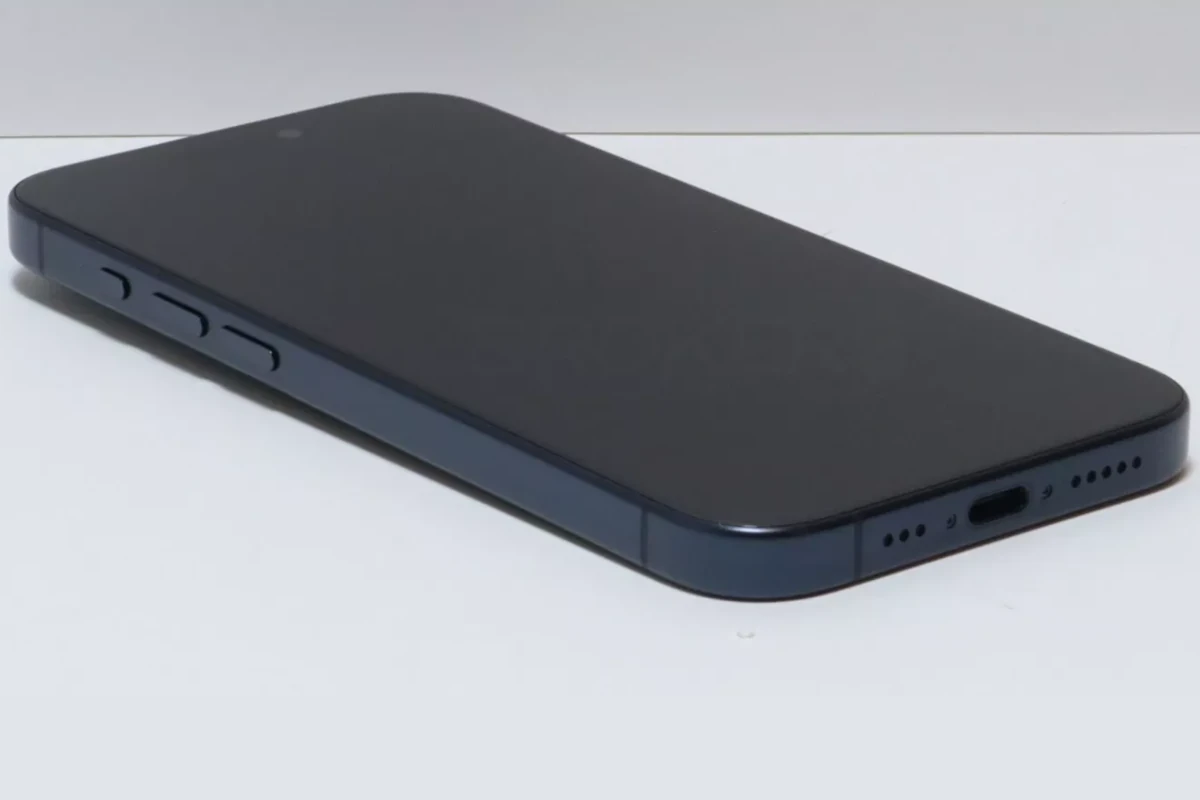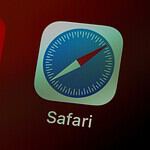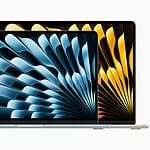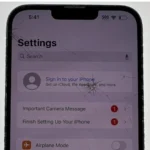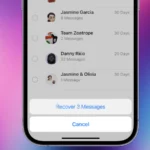Is your iPhone screen too dark to see properly? This is a common problem that can happen even with newer models. You can fix a dark iPhone screen by checking your brightness settings, turning off features like Dark Mode or Night Shift, and making sure Auto-Brightness isn’t dimming your display.
Many iPhone users face screen brightness issues, especially when using their phones outdoors or in bright sunlight. Your screen might suddenly appear too dim to read messages or see photos clearly. The good news is that most screen brightness problems have simple fixes that take just a few taps to solve.
The problem could be caused by several things – your Auto-Brightness setting might be on, Dark Mode could be activated, or you might have Reduce White Point enabled in Accessibility settings. Sometimes your iPhone screen even dims automatically in sunlight due to temperature protection.
Why Your iPhone Screen Looks Too Dark
If your iPhone screen seems dim or hard to see, it’s usually due to one of these common causes:
- Auto-Brightness or True Tone adjusting your screen automatically.
- Low Power Mode limiting brightness to save battery.
- Display Zoom, Filters, or Accessibility settings altering brightness.
- Software bugs or outdated iOS versions.
- Hardware issues with the display or backlight.
🔧 Fixes for an iPhone Screen That’s Too Dark
1. Manually Increase Brightness
Start with the basics:
- Swipe down from the top-right corner (or up from the bottom on older iPhones).
- Drag the brightness slider all the way up.
Or go to:
Settings → Display & Brightness → Brightness and adjust the slider.
(source: Apple Support)
2. Turn Off Auto-Brightness
Auto-Brightness dims your screen based on ambient light.
To disable it:
Settings → Accessibility → Display & Text Size → Auto-Brightness → Off.
This keeps your screen consistently bright regardless of lighting conditions.
3. Disable True Tone and Night Shift
These features adjust color temperature, which can make the screen appear dimmer.
- Go to Settings → Display & Brightness.
- Turn off True Tone and Night Shift.
4. Check Low Power Mode
When Low Power Mode is on, iPhone may reduce brightness to save energy.
Go to Settings → Battery → Low Power Mode and toggle it off.
5. Check Reduce White Point
This accessibility feature lowers the intensity of bright colors.
- Go to Settings → Accessibility → Display & Text Size.
- Scroll down and make sure Reduce White Point is off, or set it below 25%.
(source: Payette Forward)
6. Turn Off Dark Mode
Dark Mode can make the screen look dimmer, especially in bright environments.
Go to Settings → Display & Brightness → Appearance → Light.
7. Check for Screen Zoom or Display Filters
If your screen looks unusually dark or tinted:
- Go to Settings → Accessibility → Display & Text Size → Color Filters.
- Make sure Color Filters are turned off.
- Also check Settings → Display & Brightness → Display Zoom and set it to Standard.
8. Restart Your iPhone
A quick restart can fix temporary display bugs.
- Press and hold Side + Volume Up (or Down) → Slide to power off → Wait 30 seconds → Turn back on.
9. Update iOS
Apple frequently fixes display-related bugs in updates.
Go to Settings → General → Software Update and install the latest version.
(source: iOS Hacker)
10. Reset All Settings (Last Resort)
If none of the above works, reset all settings to restore default display configurations:
Settings → General → Transfer or Reset iPhone → Reset → Reset All Settings.
This won’t delete your data, but it will reset display and accessibility settings.
⚙️ If the Screen Is Still Too Dark
If your iPhone remains dim even after trying all these steps, it could be a hardware issue — such as a failing backlight or display connector. In that case:
- Try shining a flashlight on the screen — if you can faintly see content, the backlight may be failing.
- Contact Apple Support or visit an Apple Store for a diagnostic.
✅ Quick Summary
| Problem | Likely Cause | Fix |
|---|---|---|
| Screen dims automatically | Auto-Brightness | Turn off Auto-Brightness |
| Screen looks warm/yellow | True Tone or Night Shift | Disable both |
| Screen still dim at full brightness | Reduce White Point or Low Power Mode | Turn off both |
| Screen dim only in some apps | App-specific issue | Restart or reinstall app |
| Screen always dark | Hardware issue | Contact Apple Support |
💡 Tip:
To keep your screen bright and battery healthy, use Auto-Lock set to 1–2 minutes and avoid full brightness outdoors for long periods.
In summary:
If your iPhone screen is too dark, start by checking brightness, Auto-Brightness, True Tone, and Reduce White Point settings. If the issue persists, update iOS or reset settings — and if it’s still dim, a hardware repair may be needed.
Key Takeaways
- Check and adjust your brightness slider in Control Center for a quick fix to a dark screen.
- Turn off Auto-Brightness, Dark Mode, and Night Shift if your iPhone screen keeps dimming.
- Look in Accessibility settings to disable Reduce White Point if your screen appears unusually dim.
Understanding iPhone Screen Brightness
iPhone screen brightness plays a key role in your viewing experience. The right brightness level helps you see your screen clearly in different lighting conditions while also saving battery life.
Role of Ambient Light Sensor
The iPhone uses an ambient light sensor located at the top of the device. This tiny sensor measures the light in your surroundings and helps adjust your screen accordingly.
In bright sunlight, you might notice your screen seems darker despite being at full brightness. This happens because the sensor is working to balance visibility and power consumption.
Sometimes, the sensor gets blocked or dirty. Wiping the top portion of your iPhone can help if your screen seems unusually dim. Dust or smudges might be preventing the sensor from accurately reading light levels.
The sensor works automatically with the Auto-Brightness feature. When this feature is on, your iPhone will continuously adjust screen brightness based on your environment.
Brightness Adjustment Features
iPhones offer several ways to adjust screen brightness. The most common method is using the brightness slider in Control Center or Settings.
To access brightness controls quickly:
- Swipe down from the top-right corner (on newer models)
- Go to Settings > Display & Brightness
- Drag the slider right to make the screen brighter
The Auto-Brightness feature can be turned on or off. To manage this setting:
- Go to Settings > Accessibility
- Tap Display & Text Size
- Toggle Auto-Brightness on or off
Some users prefer to turn off Auto-Brightness when it dims the screen unexpectedly, especially in sunlight. Manual control gives more consistent results in challenging lighting conditions.
For better visibility, users can also try Dark Mode, which reduces eye strain in low-light environments while preserving battery life.
Troubleshooting Dark iPhone Screens
If your iPhone screen appears too dark, several settings might be causing this issue. Fixing a dark screen often involves checking your environment, adjusting brightness features, and disabling certain accessibility options.
Assessing Lighting Conditions
Your iPhone’s display might seem dark because of where you’re using it. Bright sunlight can make screens harder to see, even at maximum brightness. Try moving to a shadier spot if you’re outdoors.
Some iPhones dim automatically in dark rooms to save power, especially when watching videos. This helps extend battery life but can make the screen too dark.
If your iPhone feels hot, it might reduce screen brightness to cool down. This is a safety feature. Let your device cool off before trying other fixes.
Check if your screen protector is reducing visibility. Older or low-quality protectors can darken your display over time. Consider removing or replacing it if it looks worn.
Checking Auto-Brightness Settings
Your iPhone might be adjusting brightness automatically based on ambient light. While helpful for battery life, this feature sometimes makes the screen too dark.
To disable Auto-Brightness:
- Open Settings
- Tap Accessibility
- Select Display & Text Size
- Scroll down and turn off Auto-Brightness
You can also manually adjust brightness by:
- Swiping down from the top-right corner to open Control Center
- Dragging the brightness slider up
- Or going to Settings > Display & Brightness and moving the slider
Dark Mode can make your screen appear darker. To turn it off, go to Settings > Display & Brightness and select Light instead of Dark.
Disabling Reduce White Point
The Reduce White Point feature can make your iPhone screen appear darker by lowering the intensity of bright colors. Many users enable this accidentally.
To turn it off:
- Go to Settings
- Tap Accessibility
- Select Display & Text Size
- Find Reduce White Point and switch it off
If your screen is still dim, check if True Tone is enabled. This feature adjusts screen colors based on ambient lighting but can sometimes make displays darker. Disable it by going to Settings > Display & Brightness and toggling off True Tone.
Turning off Reduce White Point can significantly brighten your iPhone screen by restoring full color intensity. This setting is especially helpful when other methods don’t work.
Manual Brightness Adjustment
If your iPhone screen is too dark, you can quickly fix this by adjusting the brightness level. Apple provides two simple ways to control your screen brightness without needing any special tools or skills.
Adjusting Brightness via Control Center
The fastest way to fix a dark iPhone screen is through Control Center. Here’s how:
- Swipe down from the top-right corner (iPhone X or later) or up from the bottom edge (iPhone 8 or earlier).
- Find the brightness slider (sun icon).
- Drag the slider up to make your screen brighter.
This method works even when you’re using apps or playing games. You can make small adjustments until you find the perfect brightness level for your eyes and environment.
For outdoor use, you’ll likely need maximum brightness. In darker rooms, a lower setting works better for your eyes and saves battery life.
Adjusting Brightness in Settings
For more control over your iPhone’s screen brightness, use the Settings app:
- Open Settings on your iPhone.
- Tap “Display & Brightness.”
- Use the slider to adjust your screen brightness by dragging right (brighter) or left (dimmer).
While in Settings, check if Auto-Brightness is on. This feature automatically adjusts screen brightness based on your surroundings. To control this:
- Go to Settings > Accessibility > Display & Text Size
- Scroll down to find Auto-Brightness
- Toggle it off if you want full manual control
Some users report their screen dims in bright sunlight even with auto-brightness off. This happens because iPhones have thermal protection that dims the screen when the device gets too hot.
Advanced Solutions for Screen Brightness Issues
When basic brightness adjustments don’t work, you may need more powerful fixes. These methods can solve persistent iPhone screen darkness problems that resist simple solutions.
Reset All Settings Option
If your iPhone screen remains too dark even at maximum brightness, a Reset All Settings operation might help. This process clears out system configurations that could be causing display issues.
To perform this reset:
- Go to Settings > General > Transfer or Reset iPhone
- Tap Reset > Reset All Settings
- Enter your passcode when prompted
- Confirm your choice
This action won’t delete your photos, apps, or other content. It only returns settings to factory defaults. Your brightness controls, display accommodations, and other screen-related settings will reset.
Many users have found this fixes screen brightness problems caused by software glitches. After the reset, you’ll need to reconnect to Wi-Fi networks and adjust your preferences again.
Seeking Professional Tech Support
When resets and other self-help solutions fail, it’s time to consult experts. Professional tech support can determine if your dark screen stems from hardware failures.
Apple Support offers help through several channels:
- Genius Bar appointments at Apple Stores
- Online chat support
- Phone assistance
- Mail-in repair options
For quick answers without appointments, services like JustAnswer connect you with Verified Experts who can diagnose unusual screen issues remotely. These specialists can tell if your screen’s backlight is failing or if the ambient light sensor is malfunctioning.
Before contacting support, try taking screenshots of your dark screen. If the screenshots appear normal when viewed on another device, this suggests a hardware issue rather than a software problem.
Preventive Measures and Best Practices
Taking steps to prevent screen brightness issues can save you time and frustration. These simple habits help maintain optimal display settings and extend battery life.
Regularly Updating iOS
Keeping your iPhone’s operating system current is key to preventing screen brightness problems. Apple often fixes bugs that affect display settings in their updates.
To check for updates, go to Settings > General > Software Update. If an update is available, connect to Wi-Fi and plug your iPhone into a power source before downloading.
Updates sometimes reset your brightness settings. After updating, check if your auto-brightness feature is turned on or off based on your preference.
Some users report seeing a dim Apple logo during startup after updates. This is normal and not a sign of a screen brightness problem.
Maintaining Optimal Lighting Conditions
Your environment plays a big role in how your screen brightness works. The iPhone’s light sensors adjust display brightness based on surrounding light.
Keep the top of your iPhone clean, as this is where light sensors are located. Dust or smudges can trick sensors into thinking it’s darker than it actually is.
When moving between very bright and dark places, give your iPhone a moment to adjust. The sensors need time to read the new light levels.
Set up your regular work space with steady lighting. This helps prevent your iPhone from constantly changing brightness levels, which can be annoying.
Try to avoid using your phone in direct sunlight for long periods, as this can make the screen appear dark and strain your eyes.
Frequently Asked Questions
iPhone screens can sometimes seem too dark even when settings appear correct. These common questions address brightness issues and provide practical solutions to make your screen more visible.
What steps can I take to resolve a dimly lit iPhone display despite maximum brightness settings?
If your iPhone screen appears dim even at maximum brightness, first check if Night Shift or True Tone is active. These features can make your display appear darker.
You should also wipe the top of your iPhone where the ambient light sensor is located. Dust or fingerprints can block this sensor and cause brightness problems.
Restarting your iPhone might help too. Sometimes a simple reboot can fix minor software glitches affecting screen brightness.
How can I troubleshoot an iPhone screen that remains dark even when the phone is powered on?
Check if your iPhone is in Low Power Mode, which reduces screen brightness to save battery. Look for a yellow battery icon in the status bar.
If the screen is black but the phone makes sounds, the display might be damaged. Contact Apple Support to discuss repair options.
Try a force restart by quickly pressing the volume up button, then volume down button, then holding the side button until the Apple logo appears.
What causes an iPhone’s screen brightness to fluctuate even with auto-brightness disabled?
Temperature can cause brightness fluctuations. iPhones may dim automatically when they get too hot to prevent damage.
Some apps might override brightness settings temporarily. This happens especially with camera and video apps.
System updates might reactivate auto-brightness. Double-check your settings after updating iOS.
How can I manually adjust the screen brightness on an iPhone if automatic settings are not functioning properly?
Open Control Center by swiping down from the top-right corner (or up from the bottom on older iPhones). Adjust the brightness slider with your finger.
Alternatively, go to Settings > Display & Brightness and drag the brightness slider to the right to make the screen brighter.
Make sure to turn off Auto-Brightness in Settings > Accessibility > Display & Text Size to maintain your manual setting.
What should I do if my iPhone’s screen is excessively dark after ensuring the brightness is set to its highest?
Check if Reduce White Point is enabled in Settings > Accessibility > Display & Text Size. This feature can make your screen appear darker.
Look for screen protectors or cases that might be blocking light. Some privacy screen protectors significantly reduce brightness.
If nothing else works, try resetting all settings. Go to Settings > General > Reset > Reset All Settings (this won’t delete your data).
Why might an iPhone screen appear darker than expected and how can I correct this issue?
Dark Mode might be enabled, making everything appear darker. Go to Settings > Display & Brightness and select Light instead of Dark.
Sunlight can make screens appear dimmer due to contrast issues. Find shade or increase brightness to maximum when outdoors.
Check for physical damage like liquid damage or screen separation that might affect display brightness. These issues require professional repair.

